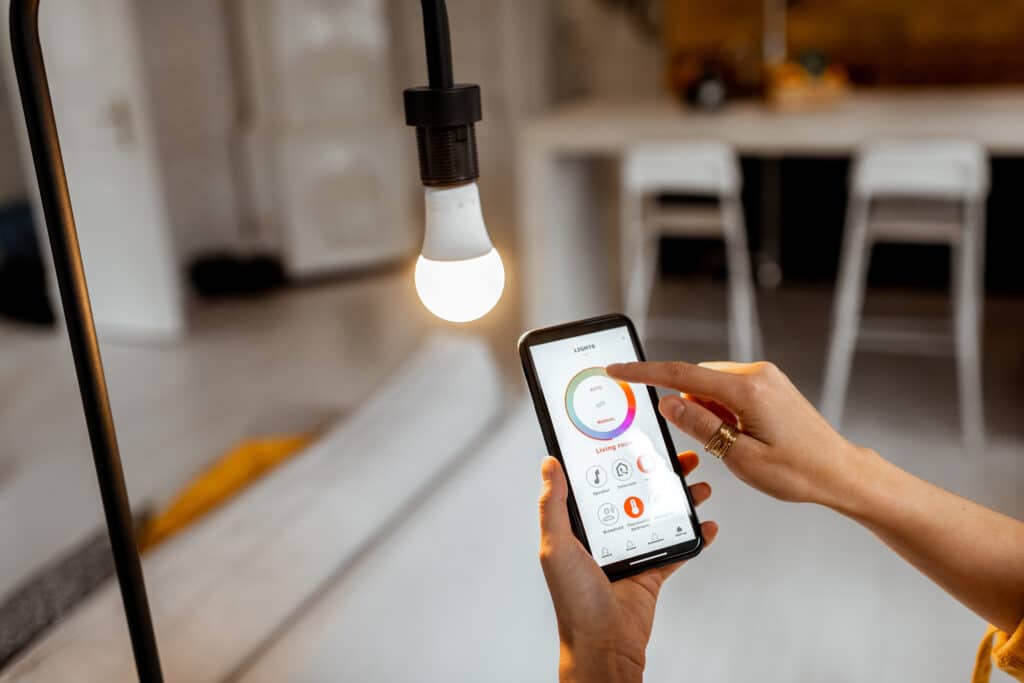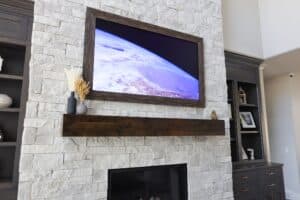Smart home lighting can be a great option for those looking to reduce monthly electrical costs without sacrificing the comfort of your home. Smart home lighting refers to the integration of technology into home lighting systems, enabling homeowners to control their lights through mobile devices, programming, and even voice commands. This innovation not only enhances convenience and control but can also lead to substantial savings in electricity consumption. The benefit of smart lighting is its versatility: by strategically implementing this technology, you can reduce your monthly energy costs without sacrificing your home’s comfort or aesthetic appeal. In this article, we will explain how smart lighting can save electricity, the different options available, and how to make the switch to smart lighting efficiently.
How do Smart Home Lighting Systems Save Energy?
Investing in a smart home lighting system may require an upfront cost, but the long-term savings are well worth it. There are several key features that enable these systems to save electricity:
Energy-efficient LED Bulbs
One of the primary components of smart home lighting is energy-efficient LED bulbs. These bulbs use significantly less energy than traditional incandescent or fluorescent lights. LED bulbs convert more energy into light and produce less heat, making them an ideal choice for homeowners looking to decrease their electricity consumption.
Dimming Capabilities
Smart lighting systems often include dimming capabilities, allowing you to adjust the brightness levels according to your needs and preferences. By dimming the lights when full brightness is unnecessary, you can reduce energy usage while still maintaining a comfortable lighting environment.
Automated Scheduling
With smart lighting, you have the ability to schedule when your lights turn on and off automatically. This feature ensures that lights are only active when needed, preventing unnecessary energy consumption during vacant periods or daylight hours.
Motion Sensors and Occupancy Detection
Another way smart home lighting systems save electricity is through motion sensors and occupancy detection. These sensors can detect when a room is unoccupied and automatically turn off the lights after a specified period of inactivity.
Smart Home Lighting Options
Whether you are looking to improve the lighting in certain areas or redesign the lighting in your entire home, options are available for any budget.
Smart Bulbs
Many homeowners look at smart bulbs when building their smart lighting solution. These bulbs are easy to install and connect directly to your Wi-Fi network. Controlling smart bulbs is also a simple process; most bulbs come with their own mobile application to control your lights with your phone. Most smart bulbs also have the capability of integrating with Alexa and Google, allowing you to use voice commands when needed.
Smart Light Switches
Smart switches are often the go-to choice for homeowners looking to get a cost-efficient smart lighting system. These switches replace traditional wall switches and allow you to control your lights through smartphone apps or voice assistants. Instead of investing in many different smart bulbs, smart switches can be wired to several bulbs in a room. However, they can only control the bulbs they are hardwired to and need professional installation. Our smart bulbs vs. smart switches guide can provide more information on the differences between these two popular options.
Whole-Home Lighting Systems
While smart bulbs and smart switches can be sufficient in some scenarios, we always recommend a whole-home lighting system with wired integration. These systems, like Lutron, require professional installation but offer seamless integration with other smart home devices and hubs. The wired integration allows control over your home lighting without needing Wi-Fi, making your lighting more secure and dependable. A whole home system also allows you to control all your lighting from one central location, like a smart panel or mobile application. While being more expensive, these systems are the most comprehensive and advanced lighting solutions on the market.
Integration with Other Smart Devices
Integration
Smart home lighting can seamlessly integrate with various other smart devices, enhancing the look and feel of your home while optimizing energy savings. By linking your lighting system to devices such as thermostats, sensors, and home audio systems, you can create intelligent automation scenarios that respond to occupancy and environmental factors, improving energy efficiency.
Centralized Control
A central control hub can integrate and control your entire smart home, syncing your lighting with the other smart systems you may have in place. Alexa and Google are the most common smart home hubs due to their ease of use and availability. However, these systems have drawbacks, such as reliance on Wi-Fi and limited integration with more advanced systems. A wired control hub, like ELAN, offers better integration and reliability. It is also much easier to scale your lighting and other systems with a wired hub in place.
How to Get Started with Smart Lighting
Now that you are aware of some of the smart lighting options on the market and how they save energy, you might be wondering how to get started with smart lighting. Below are some steps to follow to ensure the transition to smart lighting is as smooth as possible.
- Evaluate Your Needs: Assess your current lighting setup and identify areas where smart lighting could make a significant impact. Determine whether you prefer individual control over each light or if group control would suffice.
- Research Products: Explore different smart lighting options, considering factors such as compatibility with your existing devices, process of installation, and energy-saving features.
- Professional Installation: While some smart lighting systems can be installed as DIY projects, professional installation ensures optimal performance and integration with other smart home devices.
- Experiment and Customize: Once your smart lighting system is up and running, take the time to explore its features fully. Experiment with scheduling, dimming, and creating personalized scenes to find the perfect balance between comfort and energy efficiency.
As with any smart home project, we recommend consulting with a smart home professional to bring your ideas to life. This will ensure no mistakes are made, and your smart home is customized to your liking.
Make the Switch to Smart Home Lighting with AIS
Adopting smart home lighting is a forward-thinking choice for homeowners who value
both the environment and their wallets. These advanced systems not only bring convenience and style to your home but also save you money each month. With a variety of options available, making the switch has never been easier or more beneficial. Still have questions or looking for the next steps for your home? Contact us today or get started with your smart home lighting solution with AIS.




